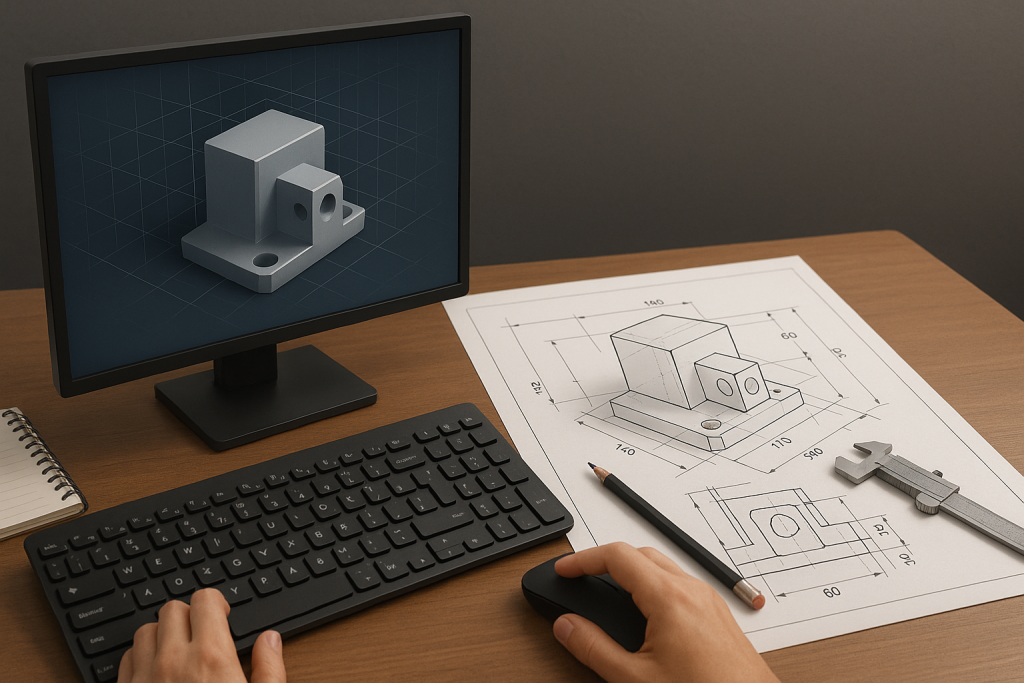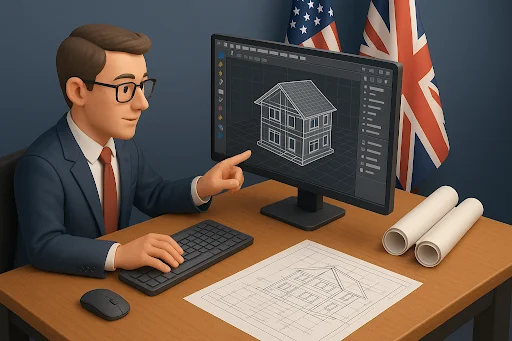In recent years, something big has been happening across the engineering, architectural, and manufacturing landscapes in both the UK and the USA. More businesses from startups to established enterprises are rethinking the way they approach product design, infrastructure planning, and technical documentation. The shift is clear: companies are rapidly moving away from traditional 2D drawings and embracing modern 3D modeling as their new standard.
Whether driven by competitiveness, accuracy demands, or digital transformation initiatives, this transition shows no sign of slowing down. For many organizations, investing in 2D to 3D CAD conversion services or learning how to efficiently convert 2D drawing to 3D model has become essential, not optional.
So what’s behind this shift? And why is the UK seeing a particularly strong surge in digital design adoption? Let’s explore.
Why Are Businesses Moving Away from Traditional 2D Drafting?
For decades, 2D drafting was the industry standard. But as product complexity grew and digital tools evolved, 2D drawings began to reveal significant limitations:
- Higher risk of misinterpretation
- Restricted visualization of real-world geometry
- Time-consuming revision cycles
- Poor compatibility with modern manufacturing equipment
- Difficulty collaborating across dispersed teams
In contrast, 3D modeling provides a level of clarity, precision, and flexibility that 2D simply cannot match.
A report from Grand View Research forecasts that the global CAD market will reach $14.2 billion by 2030, driven largely by the adoption of 3D design platforms. Businesses in the UK and USA are major contributors to this growth, as digital-first project delivery becomes the new normal.
What Makes 3D Modeling More Advantageous Than 2D Drafting?

Switching from 2D to 3D isn’t just about modernization it delivers real, measurable business value. Here’s why organizations are making the transition:
1. Improved Accuracy and Error Reduction
3D models drastically reduce human error by offering:
- True-to-life geometry
- Automatic clash detection
- Precise fit-and-function evaluation
According to Autodesk, companies using 3D modeling and BIM technologies report up to 40% fewer project errors compared to 2D processes.
2. Better Visualization for Stakeholders
A 2D drawing requires interpretation, but a 3D model “speaks for itself.”
Clients, manufacturers, and non-engineers can easily understand:
- Product functionality
- Material requirements
- Spatial relationships
- Design aesthetics
This improves communication and reduces costly redesign cycles.
Discover this related post filled with insights that beautifully extend your journey.
3. Faster Prototyping and Shorter Time-to-Market
With 3D models, businesses can:
- Simulate performance
- Run virtual tests
- Generate prototypes quicker
- Speed up approval workflows
This is crucial for competitive industries such as consumer electronics, automotive, and construction.
4. Seamless Integration with CNC, CAM, and 3D Printing
Modern fabrication tools rely heavily on 3D geometry.
2D files must be converted before manufacturing can begin, while 3D models integrate directly with:
- CNC machining
- 3D printing
- Injection molding
- Robotics
This compatibility significantly reduces production delays and costs.
Why Is This Trend Growing Faster in the UK?
The UK is experiencing a particular surge in 3D adoption due to several market pressures and opportunities.
Government Support for Digital Transformation
The UK government’s Construction 2025 Strategy, outlined on gov.uk, emphasizes digital adoption, BIM integration, and productivity improvements.
Modern Manufacturing Expectations
The UK’s manufacturing sector contributes £518 billion to the economy (source: Make UK) and is increasingly relying on smart manufacturing, which requires advanced CAD interoperability.
Growing Architectural and Engineering Demand
UK firms, especially in London, Manchester, and Birmingham, face increasing project complexities. 3D modeling helps meet:
- Sustainability goals
- Prefabrication requirements
- Green building certifications
This makes transitioning from 2D to 3D not just beneficial but necessary.
What Are the Biggest Challenges Businesses Face During the Transition?
The move to 3D is beneficial, but not without obstacles. The most common challenges include:
1. Legacy 2D Data
Most companies have years, sometimes decades of archived 2D drawings that still play critical roles in operations. Converting these legacy files isn’t always simple.
This is where autocad conversion services and 2D to 3D CAD conversion services become essential. Specialists ensure accuracy, consistency, and correct geometry translation.
2. Skill Gaps
3D design platforms require training.
Architects, engineers, and designers must become proficient with:
- Autodesk Inventor
- AutoCAD 3D
- SolidWorks
- Revit
- Fusion 360
Companies with limited in-house expertise often outsource.
3. Software and Technology Costs
Although subscription-based CAD tools reduce upfront costs, SMEs still find the transition financially challenging. However, the ROI usually outweighs initial investments.
How Does “2D to 3D Conversion in AutoCAD” Support Digital Transformation?
AutoCAD remains one of the most widely used design tools across the globe. Its 3D capabilities allow teams to modernize workflows without abandoning familiar software.
Converting legacy drawings using 2D to 3D conversion in AutoCAD brings several benefits:
- Smooth migration from old files to new models
- Standardized workflows
- Improved design consistency
- Compatibility with DWG-based systems
This makes AutoCAD conversion services a vital stepping stone for many organizations.
What Industries Are Benefiting the Most from 3D Modeling?
The shift from 2D to 3D is sweeping across nearly every sector, but the most active adopters include:
1. Architecture & Construction
- BIM integration
- Clash detection
- Building visualization
- Modular construction
2. Mechanical & Industrial Engineering
- Complex assemblies
- Part simulation
- Rapid prototyping
3. Manufacturing & Fabrication
- CNC programming
- Tool design
- Sheet metal modeling
4. Product Design & Consumer Goods
- Ergonomic testing
- Photorealistic rendering
- Market-ready prototyping
5. Infrastructure & Urban Planning
- Environmental analysis
- Transport planning
- Smart city modeling
What Does the Future of CAD Look Like in the UK and USA?
The next decade will push 3D modeling even further, powered by:
Generative Design
AI-driven tools that automatically produce optimized designs based on material, cost, and performance constraints.
Cloud-Based Collaboration
With tools like Fusion 360, Onshape, and BIM 360, distributed teams will collaborate in real time.
VR/AR Integration
Immersive design experiences will improve stakeholder communication and reduce early-stage uncertainty.
Digital Twins
Physical assets will have real-time digital replicas for analysis, monitoring, and optimization.
The companies that embrace 3D modeling now will be best positioned for these transformative technologies.
Conclusion:
From enhanced accuracy to better communication and production readiness, the benefits of 3D modeling are reshaping how UK and US businesses operate. Whether you’re an architect, a product developer, a startup founder, or a manufacturing decision-maker, the transition from 2D to 3D is no longer a future trend, it’s the present reality.
If your organization is exploring ways to convert 2D drawing to 3D model, or you need trusted AutoCAD conversion services, partnering with a reliable expert can save time, reduce costs, and eliminate errors. Many businesses across the UK collaborate with leading CAD companies such as a top UK-based CAD design and drafting service provider to ensure high-quality conversions and modernized design workflows.
Embracing 3D today means staying competitive tomorrow.
Explore more content designed to spark your curiosity and keep you learning forward.







